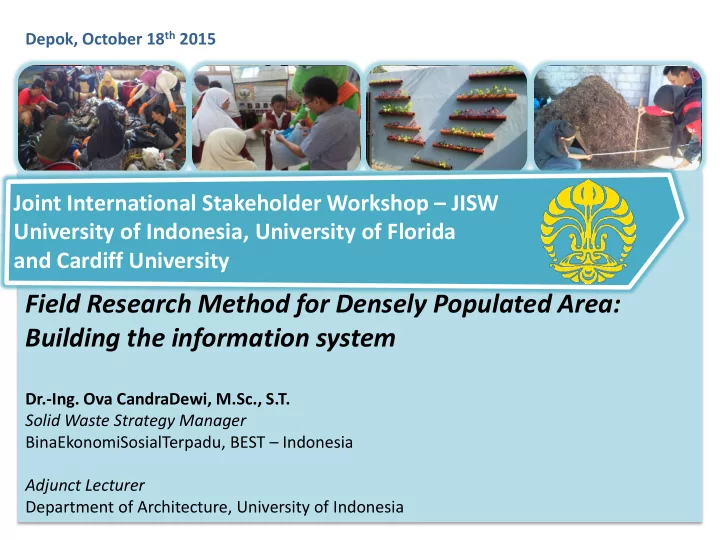

Depok, October 18 th 2015 Joint International Stakeholder Workshop – JISW University of Indonesia, University of Florida and Cardiff University Field Research Method for Densely Populated Area: Building the information system Dr.-Ing. Ova CandraDewi, M.Sc., S.T. Solid Waste Strategy Manager BinaEkonomiSosialTerpadu, BEST – Indonesia Adjunct Lecturer Department of Architecture, University of Indonesia
INDONESIA AND ASIA PACIFIC COUNTRIES Area Population Density (km 2 ) (person/km 2 ) (person) 18,000 Macau 1. China 1. China 2. Australia 2. India 3. Indonesia 3. India 4. Indonesia 4. Pakistan 5. Mongolia 124 Indonesia 2 Mongolia 252 Mio 1.9 Mio GDP per capita GDP (USD 2009) (USD 2009-20011) 800,000 3,500 ~ Thailand ~ Bangladesh India Picture: Wikipedia, 2015. Author: Abrahamic Faiths Data: http://en.wikipedia.org/wiki/Asia-Pacific -accessed 24.05.2015
CITY PROFILE: BERLIN-JAKARTA-TANGERANG SELATAN – OVERVIEW Data: http://en.wikipedia.org/wiki/Asia-Pacific -accessed 24.05.2015, DKPP 2014 Source: Wikipedia, 2015. Author: UweDedering Ag 778 488 5 e Area 891 664 147 (km 2 ) TANG-SEL JAKARTA BERLIN Population CITY 3.5 Mio 11.3 Mio 1.4 Mio (person) Density 4,000 14,400 9,500 (person/km 2 )
How to get the community aware of the improvement ideas, how we can go further?
The Case study of Cipedak Region, South Jakarta 5. Active Community Members 1. PhysicalMap 13. Waste Bin Size 9. Environmental Impact 6. Meeting Points 14. Waste Bin Allocation 10. Potential Output 2. WasteCharacterization 15. Collection Route 7. Zoning 3. Collective Actions and Community- 11. CostandBenefit Module 1 Module 1 Module 1 Module 1 BasedOrganization Data Inventory Data Inventory Data Inventory Data Inventory 1 1 1 1 Module 2 Module 2 Module 2 1-1 1-1 1-1 1-1 System Information System Information System Information & Communication & Communication & Communication Module 4 Network Network Network 2 2 2 2 1-2 1-2 1-2 1-2 Waste 5 5 5 Module 3 Module 3 2-1 2-1 2-1 Collection 3 3 3 3 System Environmental Environmental 1-3 1-3 1-3 1-3 13 Impact and Output Impact and Output 4-1 Assessments Assessments 6 6 6 9 9 2-2 2-2 2-2 4 4 4 4 3-1 3-1 14 10 10 4-2 Database Database Database Database 3-2 3-2 7 7 7 2-3 2-3 2-3 System System System System 15 11 11 3-3 3-3 4-3 8 8 8 12 12 16 Selected Selected Selected Selected Waste Selected Waste Communication Communication Communication Treatment Treatment Network Network Network Selected Collection System O.C. Dewi, 2013
MODULE 1: DATA BASE SYSTEM Case study of Cipedak Region, South Jakarta PhysicalMapInventory Database Module 1 WasteCharacteristics System Inventory Collective Actions PHYSICAL MAPS (7 Layers information)
MODULE 2: SYSTEM INFORMATION NETWORK Case study of Cipedak Region, South Jakarta Module 2 Database Communication Information System System Network The areaofinfluence 1 zone activecommunity member Meeting point Active community member Zoning
INFORMATION NETWORK In CIPEDAK – active community member Legend Case Study Feature Element Unit I II Active person 16 10 person Buffer zone I 25 10 meter Buffer zone II 50 20 meter *) Case Study I has bigger area
INFORMATION NETWORK In CIPEDAK – the meeting points Legend Case Study Feature Element Unit I II Meeting Point 2 1 point Buffer zone I 50 30 meter Buffer zone II 100 50 meter Buffer zone III 150 __ meter *) Case Study I has bigger area
INFORMATION NETWORK In CIPEDAK – zoning system Legend Case Study Feature Element Unit I II Cluster 8 7 Cluster (nofeature) Total houses 24- 59 5 - 24 house *) Case Study I has bigger area
MODULE: SYSTEM INFORMATION NETWORK houses messenger/local cadres meeting point Influenced zone, active Influenced zone, passive
How can I design policies if I dont fully understand reality on the ground? How can I design (development/social) programs if I dont grasp problem in the society? (Jokowi, formerDKI Jakarta Governor 261112 – the RI President)” In original language, Bahasa Indonesia : “Kalau lapangan enggak dikuasai, bagaimana membuat kebijakan? Kalau persoalan enggak saya kuasai di masyarakat, di lapangan bagaimana saya mendisain sebuah program? (Jokowi, Gubernur Jakarta sebelum Ahok 261112) Presiden RI”
Architecture Department – Faculty of Engineering University of Indonesia KampusBaru UI Depok, 16424 Email: ova.candra@gmail.com/085810510540
Recommend
More recommend